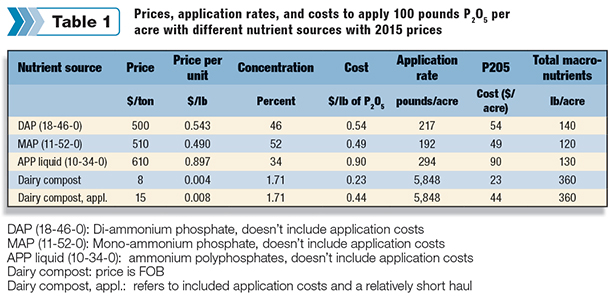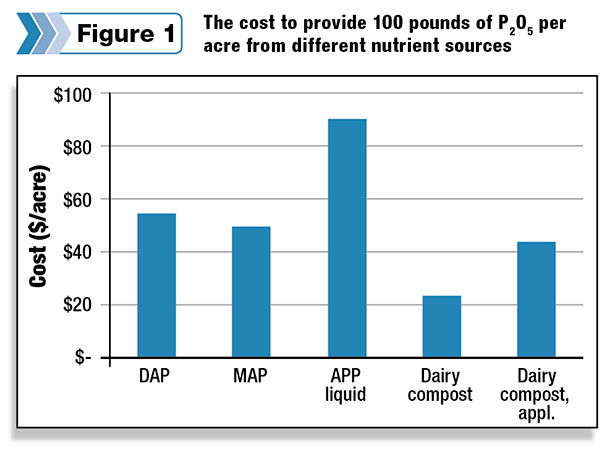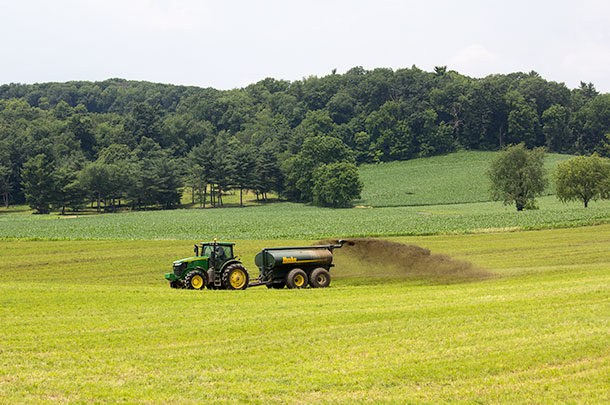You should sample at a consistent time, preferably fall in dormant alfalfa, to determine trends in soil fertility. I am a proponent of stratified sampling by management zone, areas of obviously different soil types, environment or yield potential. The conventional approach, with one sample composited from 20 cores, does not represent the variability in your soil.
Are you a nutrient miner or a sustainable farmer? Each ton of alfalfa hay exports about 60 pounds nitrogen (N), 8 pounds phosphorus (P), 50 pounds potassium (K), 30 pounds calcium and 6 pounds each of magnesium and sulfur (S). In 100 years of alfalfa hay production, 20,000 pounds potassium, 12,000 pounds calcium and 3,200 pounds of phosphorus per acre can be exported assuming a 4-ton per acre yield annually. Unless you have fed hay on, grazed, hauled manure or compost, or applied fertilizer back to those fields, this is mining the nutrients. Since alfalfa is a legume, we don’t need to worry about nitrogen export of 24,000 pounds N per acre in 100 years. Fortunately, when rotating out of alfalfa, there can be a nitrogen credit of 200 pounds for next year’s crop.
Don’t apply ounces of a nutrient per acre if you need 100 pounds of a nutrient! Generally, the least cost per package of nutrients will be manure, then compost, then bulk commercial fertilizer. Foliar nutrients may be economic in some short-term situations, but it is best to apply nutrients before you get into a catch-up situation.
Foliar fertilization is unable to provide the total plant requirements for nitrogen, phosphorus and potassium. Foliar fertilizers are most effective and economical when soil problems occur that restrict micronutrient availability, such as iron availability in high pH soils (greater than 8.3).
Another case may be in low pH soils, where lime has not been applied and several nutrients might be low in availability. Foliar fertilization should not be used as a substitute for good soil fertility management. Have your soil tested, then fertilize according to local university fertilizer guides. University trials generally show no benefit to applying foliar nutrients. Routine use of foliar fertilizers is not recommended.
Application of nutrients to maintain levels in the sufficient range is recommended, but don’t expect a yield response when levels are in the sufficient range. The goal should be to maintain sufficient levels.
Avoid applying unnecessary nutrients, such as nitrogen as ammonium phosphate on alfalfa. Use products such as ammonium phosphate on crops that need both nutrients, such as cereal grains and forages, or corn prior to alfalfa establishment. Use the product that gives you the most useable plant nutrient(s) for each dollar spent for the product and application. Don’t base your decision on the bulk price of the nutrient source. The cost per unit of plant available nutrient should be determined. Certainly cost and ease of application should be considered as well.
Case scenario
Consider the following scenario: The university fertilizer guide for an area recommends the application of 100 pounds of P2O5. Table 1 shows the calculations at December prices for several nutrient sources. The cost per pound of nutrient is highest for the liquid source at $.90 per pound of P2O5, and the least expensive is dairy compost at $.44 per pound of P2O5.

The least costly nutrient source is dairy compost in this scenario (see Figure 1). Transportation and application costs for manure and compost are significant, and double the cost assigned to a single applied nutrient. However, manure and compost are multi-nutrient sources, including macro and micro minerals, and provide organic carbon benefits. Compost supplies twice as much for macronutrients in this scenario compared with fertilizer sources. Compost and manure can be highly variable in nutrient concentrations, so ask for a composition test and for completeness of the composting process to reduce weed seed viability.

What about nitrogen fertilizer?
I discourage the use of nitrogen fertilizer on legumes because of environmental and economic concerns. Nitrogen application to alfalfa will reduce the N-fixing action of rhizobia bacteria. The most appropriate fertilizer product to supply phosphate to alfalfa should be superphosphate with 20 percent phosphate and 12 percent sulfur. Unfortunately, superphosphate is not readily available, probably because it is less profitable and dealers prefer to just stock mono-ammonium phosphate and di-ammonium phosphate. Historically, treble superphosphate (0-45-0) was the product of choice for alfalfa, and should still be if sulfur is not needed.
If you don’t read anything else, read this
I have cooperated in several fertilizer studies with compost, manure, synthetic fertilizers and foliar products. These and other university studies have verified the recommendations in our fertilizer guides. I have seen remarkable responses to P, K and S in deficient soils and no yield or forage quality benefit to applications where soil tests were in the sufficient range. I definitely recommend applications to maintain nutrient levels in the sufficient range. I have confidence that nutrient applications will be cost-effective when the guides are followed. However, a recommendation from a soil test lab or crop consultant to apply N on established alfalfa raises a red flag, and I suspect that a commission or business conflict is driving the recommendation. The vast majority of university trials show no yield or forage quality benefit to applying N on alfalfa. If soil pH or another problem is limiting effective rhizobia nodulation, fix the pH or other problem rather than applying N.
Should fertilizer applications change the soil test results? Generally, maintenance applications of nutrients by design will not improve soil test levels. It takes about 25 pounds of additional P2O5 above maintenance levels to increase the soil test level by 1 ppm. Furthermore, the most economical method of improving soil test levels is application of manure or compost.
Remember to soil test by management zone and incorporate P into the soil prior to sowing alfalfa. Apply maintenance levels of P in the fall on dormant alfalfa. Monitor potash and sulfur levels and apply according to local university fertilizer guides. FG
Glenn Shewmaker is the forage specialist with University of Idaho. Email Glenn Shewmaker.
PHOTO: Compost and manure can be highly variable in nutrient concentrations, so ask for a composition test and for completeness of the composting process to reduce weed seed viability. Photo by Lynn Jaynes.












